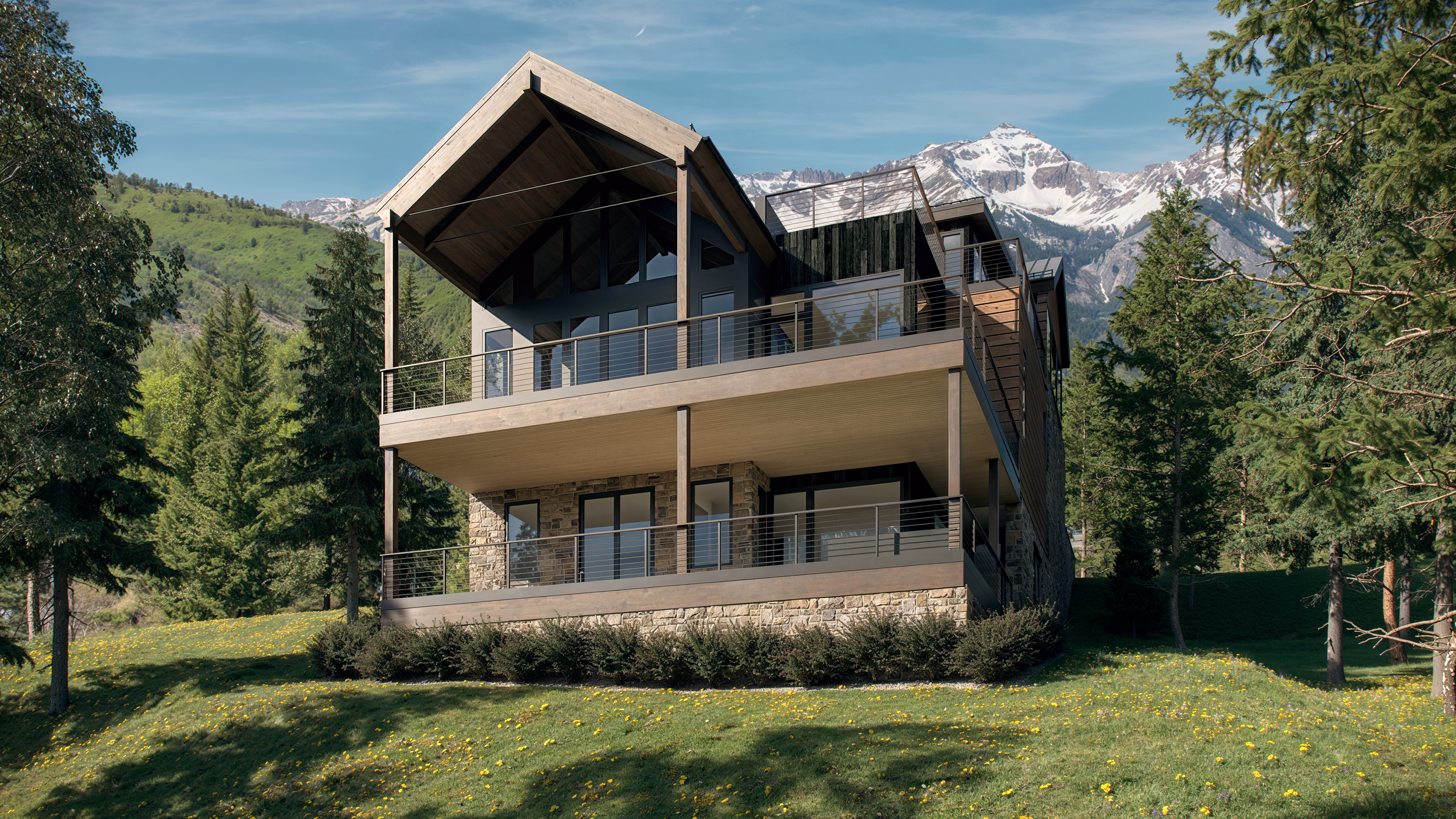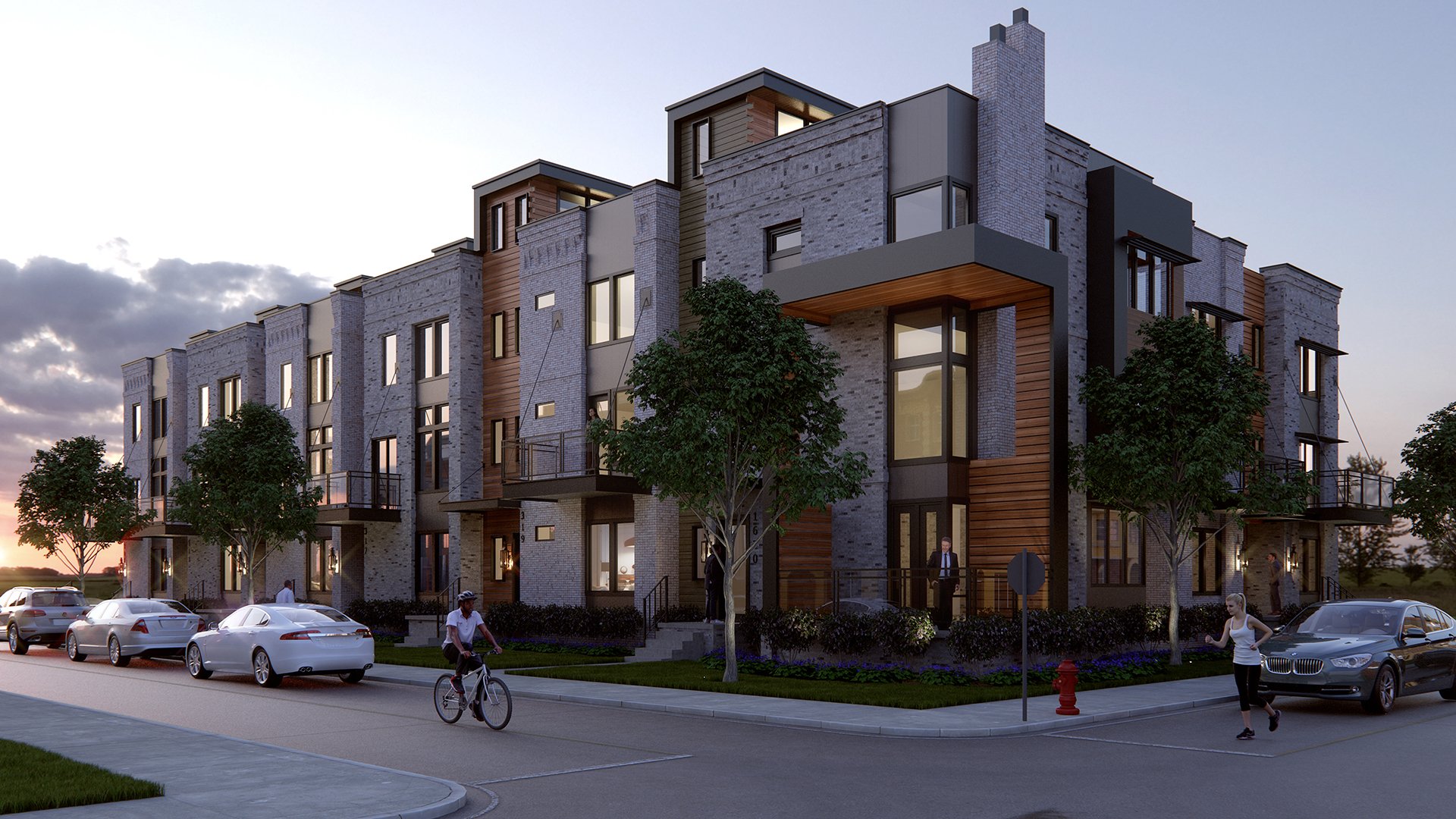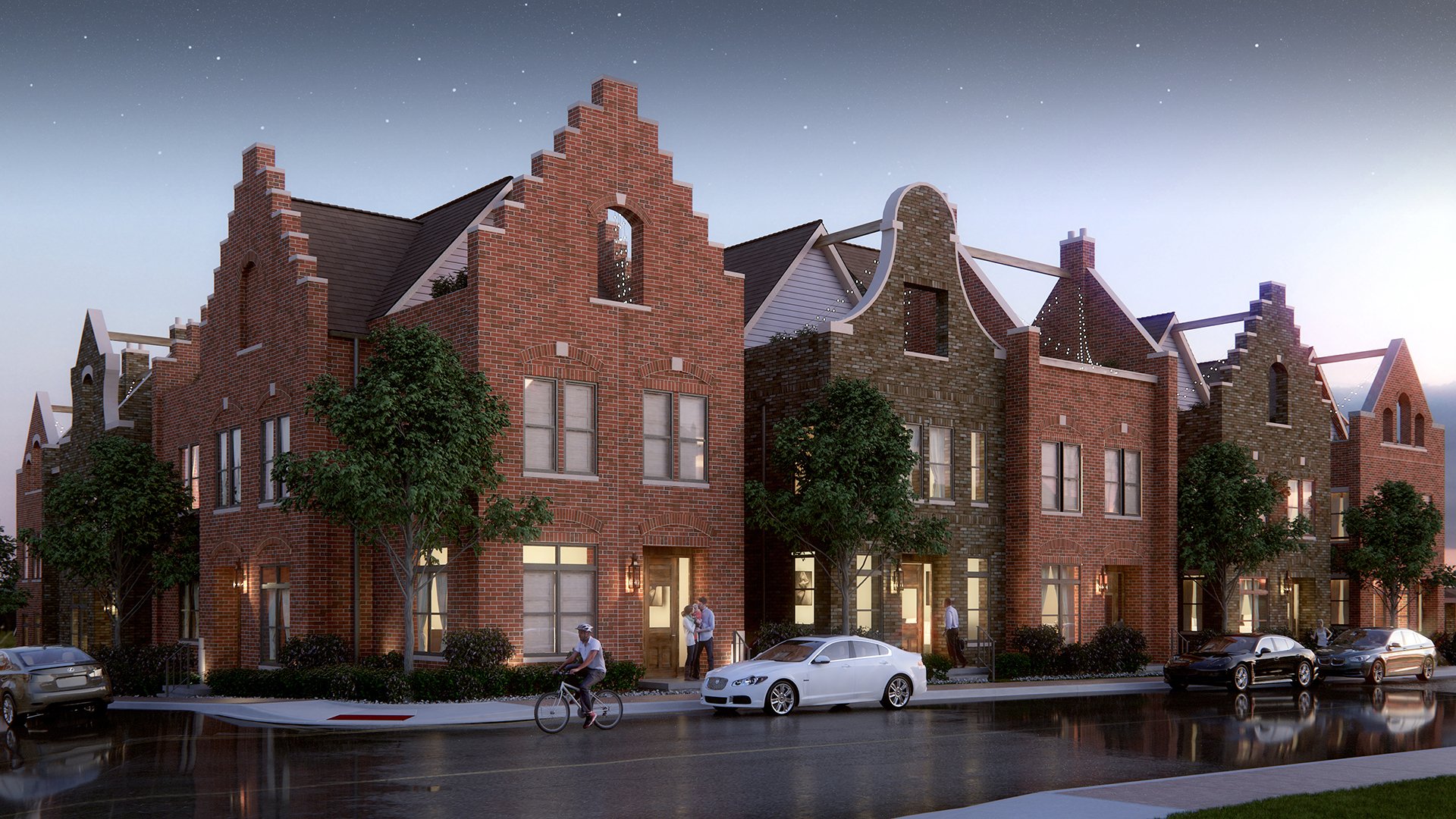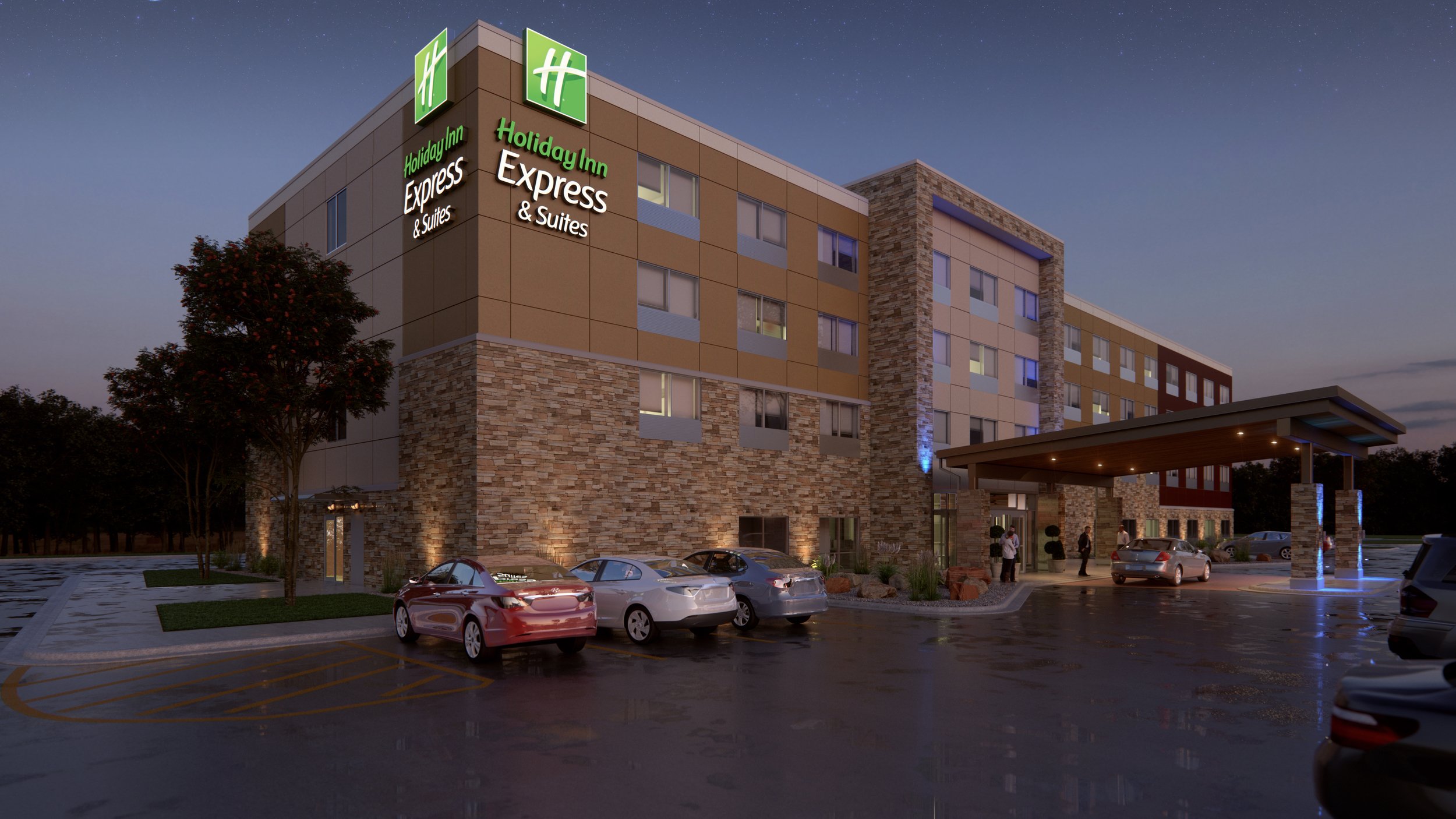Rustic Mountain House in a Serene Winter Landscape
Rustic Mountain House in a Serene Winter Landscape
This rendering uniquely portrays a rustic mountain house in a serene winter landscape. The wooden and stone elements of the house blend harmoniously with the snowy surroundings, creating a striking visual. The snow, gently covering the roof and the ground enhances the rustic charm of the house. The snow-dusted trees and the clear blue sky further contribute to the peaceful ambiance of the scene.
The composition of this rendering is compelling, with the house positioned centrally, drawing the viewer's eye to its architectural details. The texture of the wooden siding and stonework is beautifully captured, highlighting the tactile qualities of these materials. This effective use of texture adds depth and dimension to the piece. The balance between the natural landscape and the constructed environment is a testament to the illustrator’s skill and thoughtfulness, enhancing the overall appeal of the rendering.
An emotional tranquility permeates the scene, evoking a sense of peace and isolation that often accompanies a snowy landscape. The lighting is soft and natural, enhancing the subtle hues of the wood and stone and the crispness of the snow. This careful attention to lighting underscores the rendering's mastery of the medium, showcasing the ability to capture the moment authentically and beautifully.
The choice to focus on the harmony between the house and its environment is strong, and expanding on this relationship could unearth even more intriguing visual narratives, sparking the audience's curiosity and leaving them intrigued.
This rendering is a testament to a keen eye for detail and an appreciation for natural beauty. It is an excellent representation of a moment frozen in time, inviting the observer to linger and explore the subtleties it offers. There is a profound beauty in how architecture and nature are woven together in your work, inspiring the audience with the illustrator's appreciation for natural beauty.
Golden Hill Colorado animation
Art and Science
Architect drawing a house on paper
The work of an architectural illustrator is both an art and a science. Science starts with learning software, but unfortunately, that is where most archviz artists start and stop. Create a 3D model, slap some bitmaps on a plane, add some lights, and call it a day. That is where I start, minus slapping a bitmap on a plane (that is a science in itself).
Every image should have a purpose, which shouldn’t, and really can’t, be one shot showing everything equally. Every image should have a focus point; you must walk the viewer through your image using science. Unless the client dictates the view and isn’t flexible, every image has a purpose. I use light, shadow, color, contrast, and leading lines to bring viewers through my scenes.
I use several analytical tools to study my images. Some are low-tech, and others are high-tech. First, I squint my eyes, which removed detail, and distractions reveal themselves. Then I will crunch my colors so I only see bright spots, and then I’ll crunch it the other way to see dark spots; I want nothing 100% white and nothing 100% dark. Then I create a map over my scene that shows colors, what is hot (pure white) and cold (pure black), and since I work in float, or the camera world RAW, I can lighten up the dark and darken the light. Here is what that looks like.
Luminocity map
After I have my scene’s lighting balanced, with no 100% whites and no 100% blacks, I brighten what I want to be the focal point and darken everything else (very subtle). After everything is said and done, I analyze everything to ensure the viewer is looking where I want them to look. Here is what that looks like:
Heatmap
Regions
Visual Sequence
I initially intended for the fireplace to be the focal point, so I chose it to be right in the middle of my view. Since the outside is also bright, I darkened the fireplace to contrast more with the fire in the fireplace than the trees against the sky. Then, I ensured the fire was the most colorful part of my image. The whole project was a house that brings the outside in, so I got the viewer outside, then back into the darkest part of the image, via the table, and then back to the fireplace.
Final image
I can’t express enough the skill it takes to create a healthy, balanced, inviting, and pleasing image. I tell my clients that people might not know why an image is good, but they know when it is good (or bad).
When you hire a professional illustrator, you are hiring an artist who knows how to create an image, and they also learned the software to use as a tool to accomplish that.
Choas Cosmos Mention
Choas Cosmos
“When I first started, I didn't have a budget or money to spend on high-quality assets, and I would search online for free stuff, which was always poor quality,” says Bobby Parker of WhiteBirch Studios. “The amount and quality of assets in Cosmos alone almost pay for a V-Ray subscription.”
It's truly an honor to be recognized by an industry leader like Choas Group. I'm proud to use the best industry-leading software and to be invited to participate in beta programs. Your recognition means a lot to me.
I was thrilled when the Chaos Group invited me to join their Chaos Cosmos beta program. Cosmos, a comprehensive 3D content system, started with a library of over 650+ free models and HDRIs, catering to the most common architectural and design needs. Since then, it has expanded into something even more impressive.
I'm truly honored to have been featured on Choas's blog. It's a great feeling to be recognized by such an influential industry leader. I also want to express my gratitude for the link back to my website.
You can read the Choas Blog post here: https://www.chaos.com/blog/chaos-cosmos-free-3d-content-collection-launched
Why Bobby Parker and not Whitebirch Studio?
I have been asked why my website is www.Bobby-Parker.com, and my business name is Whitebirch Studios. The URL www.Bobby-Parker.com was chosen to reflect the digital nature of my work, and Whitebirch Studios was the name of my freelance business. Here is an explanation of why I transitioned from a company name to using my personal name for business.
In the early '90s, I started my career after college, and CAD was the thing to do. If you knew AutoCAD, you had value, so I mastered drafting on the computer and moved to programming the CAD software. The last thing to master was 3D, which was intimidating and nothing like it is today.
I remember modeling a computer hutch in 3D using AutoCAD, and it was difficult. I put in 10,000 hours to master 3D. Before CAD, I was a manual draftsman and a pencil and pen illustrator. The next step was using CAD to model houses, using the software to study light and shadow, and tracing the basic geometry on Vellum to start my hand rendering.
As software and hardware progressed, I was able to do more and more on the computer. When the modeling aspect of 3D was good enough on the PC, I started using the computer to render. I started using Accurender, Lightscape, 3D MAX, and currently V-Ray. Render times were wild. I left the laptop overnight and returned it in the morning to see if it was still processing.
Okay, back on topic. What is the name switch? There is a little more to the story. During and after college, I was interning. I worked for several Chicago area architects, all hand drafting. There were a few highly paid-CAD techs, but they were the elite. I had this skill, and the companies I was working for were not there yet, so I would cold-email architects about 3D renderings, which were brand new in the industry. These were the early days when even email wasn't typical. An email with a computer rendering caught people's attention, so most emails were immediately replied to (relative. People would check their email once a week). I started creating 3D renderings for architects as a side hustle.
Architectural firms took many years to seek talented 3D illustrators, and I was in high demand. I started working full-time as a 3D artist but was still working my side hustle. The side hustle was always kept separate, and no conflict of interest existed. I worked as a full-time 3D artist for about 20 years, also having my side hustle, and I was climbing the corporate ladder. I was always on the cutting edge, using my time to learn new things, which was appreciated.
In my two last full-time jobs, I was in middle management, managing software and hardware and creating 3D renderings and animations. The internet was a familiar place; I also kept no secret working for myself, and co-workers thought they were undermining me by telling my superiors about my side hustle and finding me online, which my superiors were very well aware of me doing my own thing. However, it came to a point where my employer didn't like the idea of me having my own company, Whitebirch Studios, so it was decided that I could do business under my name, not a company name.
So, there you have it. I went from Whitebirch Studios to using my name, which I was okay with. I liked the personalization of using my name so I could put my face to the name. When you hire me, you get me, along with my 30 years of experience and expertise. My passion for this work is unwavering, and I bring that dedication to every project.
When the housing market crashed, I was laid off (I worked for a home builder), and my side hustle turned into my full-time gig. The transition was not without its challenges. I had to adapt to the uncertainties of freelancing, manage my own business, and navigate the competitive market. However, I haven't looked back. It has been a decade of full-time freelancing; the lay-off was a blessing. I would never have had the courage to work for myself full-time.
Now, the last ten years haven't been easy. I drove away the day I was laid off (I had worked 12 years for that company) with my box of personal belongings, and my phone rang from a UK studio needing help. Since then, I have worked on a variety of projects, from architectural renderings to product designs, for a diverse range of clients. When that project wrapped up, another project landed on my desk, and the phone hadn't stopped ringing. I currently have 1033 clients, some of whom have small one-time projects and others for whom I do many projects.
If you have any questions or comments, please email me; I would love to connect. Your interest in my work means a lot to me. Let me know if you have a project or know someone who does.
Salt Pond Coastal House Rendering
“Thanks so much for everything! Salt Pond looks incredible!”


These coastal house renderings are a captivating portrayal of architectural finesse, showcasing a house that artfully blends traditional elements with a contemporary twist. The structure's symmetry is a sight to behold, with a sequence of evenly spaced windows that instill a sense of harmony and equilibrium. The white exterior, set off by the verdant surroundings, conjures a feeling of tranquil coastal living, while the azure sky above adds to the overall sense of peace.
The front porch, elevated with a stately set of stairs, beckons viewers into the space, creating an inviting ambiance. The clean lines and the consistent color palette enhance the composition, making it visually pleasing and harmonious. The choice of lighting in the renderings accentuates the architectural details, such as the railing and the porch's columns, creating a vivid contrast that accentuates the house's craftsmanship.
The coastal house rendering captures a comfortable, inviting home, reflecting an understanding of how architecture interacts with natural surroundings. This piece draws viewers in with its elegance and simplicity, encouraging them to appreciate the thoughtful design and setting.
Did you enjoy this article? I would love to hear your thoughts, so don’t be shy. Comment below! Please don’t forget to subscribe to my RSS-feed or follow my feed on Twitter and Facebook. ! If you enjoyed the following article, we humbly ask you to comment and help us spread the word! Or, if you would like, drop me an email.
Germantown Twilight Rendering


This twilight rendering skillfully captures a modern architectural structure at dusk, set against a sky tinged with soft pink and purple hues. The building's design, with its sleek and contemporary features, is a testament to your artistic eye. The clean lines and dark, muted palette contrast elegantly with the vibrant colors of the sunset. Large windows punctuate the facade, offering glimpses into the warmly lit interiors, suggesting a sense of life inside.
Including blurred vehicles and a cyclist in the foreground adds a dynamic, urban feel to the composition, effectively conveying movement and the hustle and bustle of city life. This juxtaposition between the calm, structured building and the lively street scene creates an engaging tension within the artwork.
Your mastery of light is particularly commendable. The way the windows emit a soft glow, balanced by the fading daylight, adds depth and realism to the scene. This interplay between artificial and natural light showcases your sophisticated understanding of how to evoke mood and atmosphere.
Overall, this piece captures an intriguing moment of urban existence, and its execution invites the viewer to pause and reflect. The composition's harmonious and dynamic elements are a testament to your artistic choices. It reflects a keen eye for modern architectural beauty and the vibrancy of city life.
Did you enjoy this article? I would love to hear your thoughts, so don’t be shy. Comment below! Please don’t forget to subscribe to my RSS-feed or follow my feed on Twitter and Facebook. ! If you enjoyed the following article, we humbly ask you to comment and help us spread the word! Or, if you would like, drop me an email.
Colorado Gold Hill Mountain House Renderings


The Colorado Gold Hill Mountain House rendering in this piece captures the majestic presence of a contemporary mountain home set against a breathtaking alpine backdrop. The structure is a harmonious blend of modern architectural lines and natural materials, skillfully integrating sleek metal roofing with textured stone and warm wood cladding. This choice of materials complements the surrounding landscape and echoes its environment's rugged elegance. The play of light and shadow across the facade adds depth and dimension, enhancing the photographic quality of the piece.
The perspective you've chosen for this Colorado Gold Hill Mountain House rendering highlights the balance between the home's geometric precision and nature's organic forms. The composition is thoughtfully crafted, leading the viewer's eye through the scene and inviting exploration of the architectural details, such as the expansive windows that seem to ask the outside in. The lush greenery framing the home further enhances the tranquility and connection to nature, evoking a sense of calm and contemplation.
The illustrator's capture of the essence of the location is substantial. It allows the viewer to feel as if they are physically present, standing in the shadows of the trees with the crisp mountain air enveloping them. This immersive quality is commendable and showcases a keen eye for detail and atmosphere.
Remember that art is a journey, and each creation provides an opportunity to discover new facets of the subject and personal artistic style. Keep embracing the majestic interplay between architecture and nature, offering endless inspiration and beauty.
Did you enjoy this article? I would love to hear your thoughts, so don’t be shy. Comment below! Please don’t forget to subscribe to my RSS-feed or follow my feed on Twitter and Facebook. ! If you enjoyed the following article, we humbly ask you to comment and help us spread the word! Or, if you would like, drop me an email.
The Power of Architectural Animations in Modern Design
Architectural animations have revolutionized how architects, designers, and clients visualize spaces before they are built. Unlike static renderings, these animations bring projects to life through dynamic, immersive storytelling.
Architectural animations, with their incorporation of motion, lighting effects, and realistic textures, allow viewers to experience space as if walking through it. This not only enhances client presentations but also plays a crucial role in identifying design flaws and improving spatial planning, thereby ensuring a more efficient and effective construction process.
Architectural animations are versatile tools that find applications in various fields, including real estate marketing. They enable developers and investors to better understand a building's flow, how natural light interacts with the space, and how materials look in different conditions, thereby enhancing the marketing of properties.
Architectural animations are not just about aesthetics. They are powerful communication tools that bridge the gap between designers and clients. By conveying complex design concepts in an engaging and accessible manner, they speed up decision-making and make the design process more efficient.
As technology continues to advance, architectural animations are poised to play an even more crucial role in shaping the future of architectural visualization. This promises a future where design is more interactive, efficient, and inspiring, leaving architects, designers, and clients alike, excited about the possibilities.
Did you enjoy this article? I would love to hear your thoughts, so don’t be shy. Comment below! Please don’t forget to subscribe to my RSS-feed or follow my feed on Twitter and Facebook. ! If you enjoyed the following article, we humbly ask you to comment and help us spread the word! Or, if you would like, drop me an email.
93 Bedford St Townhome Renderings
This townhouse rendering is an impressive composition capturing a serene townhouse scene. The focal point is a well-maintained, multi-story building with classic architectural features like symmetrical lines, large windows, and balconies. The building's light beige and cream tones are enhanced by the soft natural lighting, creating a warm and inviting atmosphere. The artist skillfully utilizes the time of day to capture shadows that add depth and dimension to the setting. In the foreground, a person on a bicycle adds a dynamic element, introducing a sense of movement and everyday life, while the surrounding greenery complements the calm and peaceful ambiance.
The strengths of this piece lie in its ability to evoke a sense of harmony and suburban tranquility. The choice of colors and lighting vividly captures an authentic and inviting moment. The balance between the architectural structure and the natural elements is well executed, suggesting a thoughtful consideration of composition.
Overall, the rendering successfully creates a welcoming narrative about community and serenity. Such compositions inspire viewers to appreciate the beauty in everyday settings. The interplay between structure and nature is compelling, underscoring the timeless appeal of well-captured environmental interactions. Keep exploring these themes, as they resonate well with audiences seeking a connection to the human and natural worlds.
Did you enjoy this article? I would love to hear your thoughts, so don’t be shy. Comment below! Please don’t forget to subscribe to my RSS-feed or follow my feed on Twitter and Facebook. ! If you enjoyed the following article, we humbly ask you to comment and help us spread the word! Or, if you would like, drop me an email.
Twilight Architectural Renderings: Capturing Mood & Atmosphere
Twilight Architectural Renderings: Capturing Mood & Atmosphere
Twilight architectural renderings, a unique visualization tool, bring designs to life with stunning realism and atmosphere. Unlike standard daytime renders, twilight scenes showcase buildings during dusk or dawn, when natural and artificial lighting blend harmoniously. This technique enhances the aesthetic appeal of structures by emphasizing warm interior glows, reflective surfaces, and ambient shadows, making the design more inviting and dynamic.
Twilight renderings, versatile in their application, are particularly effective for a wide range of residential and commercial projects. They help architects, designers, and developers convey a space's full potential, evoke emotion, and create a sense of place. This makes them ideal for marketing materials, client presentations, and real estate listings. By incorporating subtle lighting details, such as street lamps, illuminated windows, and landscape lighting, twilight renderings elevate the storytelling aspect of architectural visualization.
Creating a high-quality twilight render requires expertise in lighting, color balance, and post-production techniques. Software like V-Ray, Lumion, and Twinmotion allows artists to manipulate the environment, ensuring realistic reflections and accurate lighting. Whether highlighting a luxury home, a sleek office tower, or an urban streetscape, twilight architectural renderings add a touch of sophistication, depth, and mood that can elevate any project to a new level of elegance.
For architects and developers looking to captivate audiences, twilight renderings are essential in modern architectural visualization.




Did you enjoy this article? I would love to hear your thoughts, so don’t be shy. Comment below! Please don’t forget to subscribe to my RSS-feed or follow my feed on Twitter and Facebook. ! If you enjoyed the following article, we humbly ask you to comment and help us spread the word! Or, if you would like, drop me an email.





























